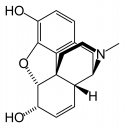Morphine: An Introduction | Discovery and Synthesis of Morphine | Addiction and Opiate Receptors | Morphine Affects History: Modern Pharmacology | History Affects Morphine: The Hypodermic Needle | History Affects Morphine II: Cultural Antipathy and Anti-Narcotics Law| References

(An lanced opium poppy; morphine is its active ingredient –
http://www.rsc.org/ej/CC/2002/b111551k/b111551k-f1.gif)
Morphine is an alkaloid molecule, a term given to “natural occurring nitrogen-containing bases found mainly in plants” (NB 249). It is one of twenty-four such alkaloids found within the resin of the opium poppy plant – Papaver somniferum – and it usually comprises 10% of all opium extract.
Designated with the chemical formula C17H19NO3, morphine exists mainly as a “bitter, white crystalline compound” (C&E News), one that is water-insoluble. It has appeared and continues to appear in a variety of other forms, however, including, but not limited to: pharmaceutical concoctions (i.e. Patent medicines), morphine acetate (salt), morphine hydrochloride (salt), and morphine sulfate (salt).
Because of these possible physical forms, morphine has been both ingested and injected throughout history, all in attempt to exploit its wonderful analgesic and euphoric effects – properties unfortunately linked to physiological addiction. It is these consequences of consumption that make morphine both an incredibly important and intriguing molecule to study. A double-edged sword in every way, morphine has been both a bane and boon to human existence.
Morphine’s Chemical Structure:
(http://upload.wikimedia.org/wikipedia/commons/6/64/Morphine-2D-skeletal.png)
JMol Image:

